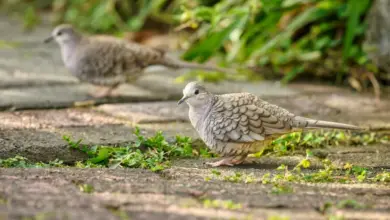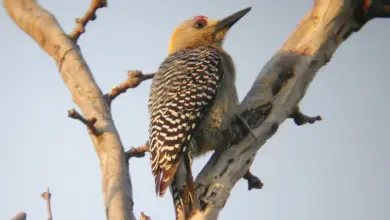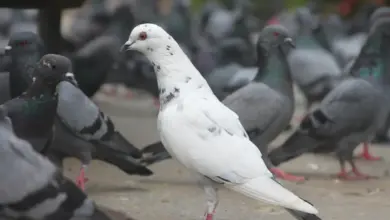Black-crested Coquettes – Hummingbirds
The Black-Crested Coquettes (Lophornis helenae) is a Central American hummingbird that occurs naturally in southern Mexico (Veracruz, Oaxaca, Chiapas) south to eastern Costa Rica.
Other Common or Global Names
English: Black crested Coquette, Black-crested Coquette, Helena’s Coquette, Princess Helena’s Coquette
Global: Spanish: Colibrí cresta negra, Coqueta Cresta Negra, Coqueta Crestibegra, Coqueta Crestinegra, Coqueta de Cresta Negra; French: Coquette d’Hélène; Italian: Colibrì coquette crestanera, Coquette crestanera; German: Schwarzschopelfe, Schwarzschopfelfe, Schwarzschopf-Elfe; Czech: Kolibrík cernokorunkatý, kolib?ík lime?kový;Danish: Sorttoppet Pragtalf; Finnish: Mustahaivenkolibri;Japanese: kurotsunoyuujohachidori;Dutch: Zwartkuifkoketkolibrie, Zwartkuif-koketkolibrie;Norwegian: Svartoppkokette;Polish: sylfik czarnoczuby;Russian: ??????? ??????;Slovak: goliercik ciernochochlý; Swedish: Svarttofskokott

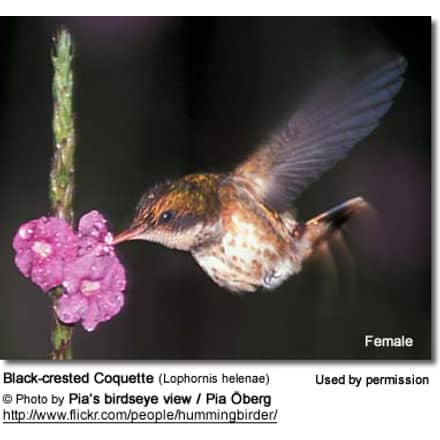

Distribution / Habitat
The Black-crested Coquette is endemic to the following Central American countries:
Belize, Costa Rica, Guatemala, Honduras, Mexico and Nicaragua.
Their preferred habitats include subtropical or tropical moist lowland forests or moist montanes, as well as heavily degraded former forest.
They are often seen along the rainforest edge.
Hummingbird Resources
- Hummingbird Information
- Hummingbird Amazing Facts
- Attracting Hummingbirds to Your Garden
- Hummingbird Species
- Feeding Hummingbirds
Description
The Black-Crested Coquette has a very short red bill with a black tip. The back is glossy green; the rump is blackish – and a white band separates the green back from the black rump. The under plumage is greenish bronze spotted. Its most distinctive feature is the white rump band.
The adult male has a long black and green crest. The throat is sparkling green with showy black-and-buff throat (gorget) feathers extending from his lower throat.
Juveniles and adult females lack the crest and throat patch of the adult male. He plumage is more brownish and generally duller.
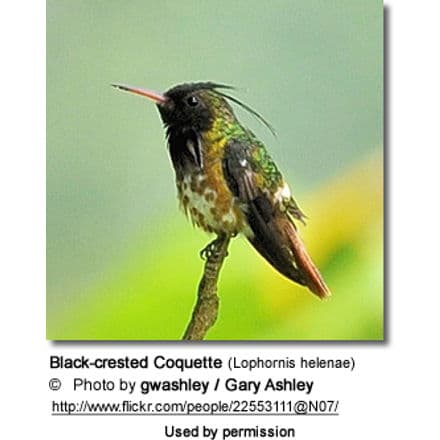
Nesting / Breeding
Hummingbirds are solitary in all aspects of life other than breeding; and the male’s only involvement in the reproductive process is the actual mating with the female. They neither live nor migrate in flocks; and there is no pair bond for this species. Males court females by flying in a u-shaped pattern in front of them. He will separate from the female immediately after copulation. One male may mate with several females. In all likelihood, the female will also mate with several males. The males do not participate in choosing the nest location, building the nest or raising the chicks.
The female Black-Crested Coquette is responsible for building the cup-shaped nest out of plant fibers woven together and green moss on the outside for camouflage in a protected location in a shrub, bush or tree. She lines the nest with soft plant fibers, animal hair and feather down, and strengthens the structure with spider webbing and other sticky material, giving it an elastic quality to allow it to stretch to double its size as the chicks grow and need more room. The nest is typically found on a low, skinny horizontal branch.
The average clutch consists of two white eggs, which she incubates alone, while the male defends his territory and the flowers he feeds on. The young are born blind, immobile and without any down.
The female alone protects and feeds the chicks with regurgitated food (mostly partially-digested insects since nectar is an insufficient source of protein for the growing chicks). The female pushes the food down the chicks’ throats with her long bill directly into their stomachs.
As is the case with other hummingbird species, the chicks are brooded only the first week or two, and left alone even on cooler nights after about 12 days – probably due to the small nest size. The chicks leave the nest when they are about 20 days old.
Diet / Feeding
The Black-Crested Coquettes primarily feed on nectar taken from a variety of brightly colored, scented small flowers of trees, herbs, shrubs and epiphytes.

